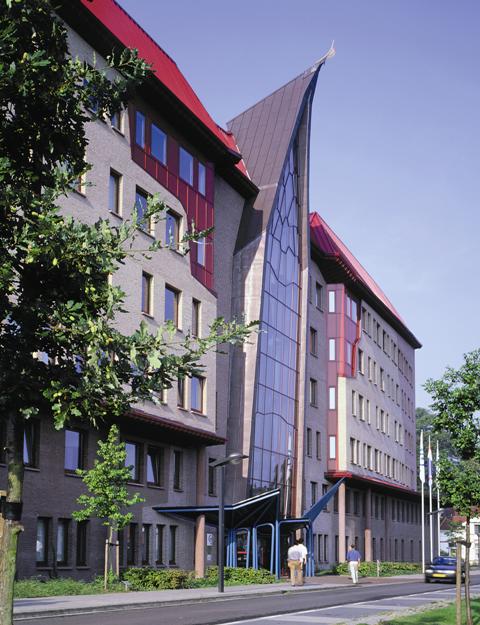|
Discontinuity (Geotechnical Engineering)
In geotechnical engineering, a discontinuity (often referred to as a joint) is a plane or surface that marks a change in physical or chemical characteristics in a soil or rock mass. A discontinuity can be, for example, a bedding, schistosity, foliation, joint, cleavage, fracture, fissure, crack, or fault plane. A division is made between mechanical and integral discontinuities. Discontinuities may occur multiple times with broadly the same mechanical characteristics in a discontinuity set, or may be a single discontinuity. A discontinuity makes a soil or rock mass anisotropic. Mechanical A mechanical discontinuity is a plane of physical weakness where the tensile strength perpendicular to the discontinuity or the shear strength along the discontinuity is lower than that of the surrounding soil or rock material. Integral An integral discontinuity is a discontinuity that is as strong as the surrounding soil or rock material. Integral discontinuities can change into mechanical disc ... [...More Info...] [...Related Items...] OR: [Wikipedia] [Google] [Baidu] |
Geotechnical Engineering
Geotechnical engineering, also known as geotechnics, is the branch of civil engineering concerned with the engineering behavior of earth materials. It uses the principles of soil mechanics and rock mechanics to solve its engineering problems. It also relies on knowledge of geology, hydrology, geophysics, and other related sciences. Geotechnical engineering has applications in military engineering, mining engineering, petroleum engineering, coastal engineering, and offshore construction. The fields of geotechnical engineering and engineering geology have overlapping knowledge areas. However, while geotechnical engineering is a specialty of civil engineering, engineering geology is a specialty of geology. History Humans have historically used soil as a material for flood control, irrigation purposes, burial sites, building foundations, and construction materials for buildings. Dykes, dams, and canals dating back to at least 2000 BCE—found in parts of ancient Egypt, ancient Mes ... [...More Info...] [...Related Items...] OR: [Wikipedia] [Google] [Baidu] |
Asperity (geotechnical Engineering)
In geotechnical engineering and contact mechanics the term asperity is used to refer to individual features of unevenness (''roughness'') of the surface of a discontinuity, grain, or particle with heights in the range from approximately 0.1 mm to the order of metres. Below the asperity level, surface interactions are normally considered to be a ''material'' property, arising from mechanisms of adhesion and repulsion at the atomic scale (often accounted for by ''material friction'', ''atomic friction'' or ''molecular friction''). Dilation An often used definition for ''asperities'' in geotechnical engineering: Unevenness of a surface are ''asperities'' if these cause dilation if two blocks with in between a discontinuity with matching ''asperities'' on the two opposing surfaces (i.e. a ''fitting discontinuity'') move relative to each other, under low stress levels that do not cause breaking of the ''asperities''. Contrast with asperity in materials science Materials science r ... [...More Info...] [...Related Items...] OR: [Wikipedia] [Google] [Baidu] |
International Organization For Standardization
The International Organization for Standardization (ISO ; ; ) is an independent, non-governmental, international standard development organization composed of representatives from the national standards organizations of member countries. Membership requirements are given in Article 3 of the ISO Statutes. ISO was founded on 23 February 1947, and () it has published over 25,000 international standards covering almost all aspects of technology and manufacturing. It has over 800 technical committees (TCs) and subcommittees (SCs) to take care of standards development. The organization develops and publishes international standards in technical and nontechnical fields, including everything from manufactured products and technology to food safety, transport, IT, agriculture, and healthcare. More specialized topics like electrical and electronic engineering are instead handled by the International Electrotechnical Commission.Editors of Encyclopedia Britannica. 3 June 2021.Inte ... [...More Info...] [...Related Items...] OR: [Wikipedia] [Google] [Baidu] |
Taylor & Francis
Taylor & Francis Group is an international company originating in the United Kingdom that publishes books and academic journals. Its parts include Taylor & Francis, CRC Press, Routledge, F1000 (publisher), F1000 Research and Dovepress. It is a division of Informa, a United Kingdom-based publisher and conference company. Overview Founding The company was founded in 1852 when William Francis (chemist), William Francis joined Richard Taylor (editor), Richard Taylor in his publishing business. Taylor had founded his company in 1798. Their subjects covered agriculture, chemistry, education, engineering, geography, law, mathematics, medicine, and social sciences. Publications included the ''Philosophical Magazine''. Francis's son, Richard Taunton Francis (1883–1930), was sole partner in the firm from 1917 to 1930. Acquisitions and mergers In 1965, Taylor & Francis launched Wykeham Publications and began book publishing. T&F acquired Hemisphere Publishing in 1988, and the compa ... [...More Info...] [...Related Items...] OR: [Wikipedia] [Google] [Baidu] |
ISRM
The International Society for Rock Mechanics - ISRM was founded in Salzburg in 1962 as a result of the enlargement of the "Salzburger Kreis". Its foundation is mainly owed to Prof. Leopold Müller who acted as President of the Society until September 1966. The ISRM is a non-profit scientific association supported by the fees of the members and grants that do not impair its free action. In 2021 the Society had 6,800 members and 49 National Groups. The field of Rock Mechanics is taken to include all studies relative to the physical and mechanical behaviour of rocks and rock masses and the applications of this knowledge for the better understanding of geological processes and in the fields of Engineering. The main objectives and purposes of the Society are: * to encourage international collaboration and exchange of ideas and information between Rock Mechanics practitioners; * to encourage teaching, research, and advancement of knowledge in Rock Mechanics; * to promote high standards ... [...More Info...] [...Related Items...] OR: [Wikipedia] [Google] [Baidu] |
ITC Enschede
The International Institute for Geo-Information Science and Earth Observation (ITC) was an institute of higher (tertiary) education located in Enschede, Netherlands. As of 1 January 2010 it has been incorporated into the Universiteit Twente, University of Twente as the sixth faculty, while preserving its unique international character as a faculty ''sui generis'', and is now formally known as University of Twente, Faculty of Geo-Information Science and Earth Observation (ITC). History and mission ITC was founded in 1950 with the name "International Training Centre for Aerial Survey" by the former Prime Minister of the Netherlands, Prof. Dr. Willem Schermerhorn to provide training in map making as an aid to developing countries. Over the years its mission has been adjusted to changing technological and development realities, so that today it offers MSc, Master's degree, Master's, Diploma and Certificate courses in Geo-information Science (GIS) and Earth Observation (EO) with ... [...More Info...] [...Related Items...] OR: [Wikipedia] [Google] [Baidu] |
Twente University
The University of Twente ( ; abbr. ) is a public technical university located in Enschede, Netherlands. The university has been placed in the top 170 universities in the world by multiple central ranking tables. In addition, the UT was ranked the best technical university in the Netherlands by Keuzegids Universiteiten, the most significant national university ranking. The UT collaborates with Delft University of Technology, Eindhoven University of Technology and the Wageningen University and Research Centre under the umbrella of 4TU and is also a partner in the European Consortium of Innovative Universities (ECIU). History The university was founded in 1961 as ''Technische Hogeschool Twente'' (''THT''). After Delft University of Technology and Eindhoven University of Technology, it became the third polytechnic institute in the Netherlands to become a university. The institution was later renamed to Universiteit Twente (University of Twente) in 1986, as the result of the cha ... [...More Info...] [...Related Items...] OR: [Wikipedia] [Google] [Baidu] |
Technical University Delft
The Delft University of Technology (TU Delft; ) is the oldest and largest Dutch public technical university, located in Delft, Netherlands. It specializes in engineering, technology, computing, design, and natural sciences. It is considered one of the leading technical universities in Europe and is consistently ranked as one of the best schools for architecture and engineering in the world. According to the QS World University Rankings it ranked 3rd worldwide for architecture and 13th for Engineering & Technology in 2024. It also ranked 3rd best worldwide for mechanical and aerospace engineering, 3rd for civil and structural engineering, 11th for chemical engineering, and 12th for design. With eight faculties and multiple research institutes, TU Delft educates around 27,000 students (undergraduate and postgraduate), and employs more than 3,500 doctoral candidates and close to 4,500 teaching, research, support and management staff (including more than 1,300 faculty members of al ... [...More Info...] [...Related Items...] OR: [Wikipedia] [Google] [Baidu] |
Tilt Test (geotechnical Engineering)
In geomechanics, a tilt test is a simple test to estimate the shear strength (discontinuity), shear strength parameters of a Discontinuity (geotechnical engineering), discontinuity. Two pieces of rock containing a discontinuity are held in hand or mounted in test equipment with the discontinuity horizontal. The sample is slowly tilted until the top block moves. The angle with the horizontal at onset of movement is called the ''tilt-angle''. The size of the specimen is limited to 10–20 cm for hand-held tests, while machine-operated tilt test equipment may handle up to meter-sized samples. In the field, the angle can be determined most easily with an inclinometer as present in most compass, geological or structural compasses. Tilt-angle The ''tilt-angle'' equals the material friction of the Discontinuity (geotechnical engineering), discontinuity wall plus the roughness i-angle (''tilt-angle'' = ''φwall material'' + ''i'') if no real cohesion is present (i.e. no cementing or g ... [...More Info...] [...Related Items...] OR: [Wikipedia] [Google] [Baidu] |
Sliding Criterion (geotechnical Engineering)
The sliding criterion (discontinuity) is a tool to estimate easily the Shear strength (Discontinuity), shear strength properties of a Discontinuity (Geotechnical engineering), discontinuity in a Rock (geology), rock mass based on visual and tactile (i.e. by feeling) characterization of the Discontinuity (Geotechnical engineering), discontinuity. The shear strength of a discontinuity is important in, for example, tunnel, Foundation (engineering), foundation, or Slope stability analysis, slope engineering, but also stability of Slope stability, natural slopes is often governed by the shear strength along discontinuities. The ''sliding-angle'' is based on the ease with which a block of rock material can move over a discontinuity and hence is comparable to the ''tilt-angle'' as determined with the Tilt test (Geotechnical engineering), ''tilt test'', but on a larger scale. The ''sliding criterion'' has been developed for stresses that would occur in slopes between , hence, in the order of ... [...More Info...] [...Related Items...] OR: [Wikipedia] [Google] [Baidu] |
Rock Mechanics
Rock mechanics is a theoretical and applied science of the mechanical behavior of rocks and rock masses. Compared to geology, it is the branch of mechanics concerned with the response of rock and rock masses to the force fields of their physical environment. Background Rock mechanics is part of a much broader subject of geomechanics, which is concerned with the mechanical responses of all geological materials, including soils. Rock mechanics is concerned with the application of the principles of Engineering Mechanics, engineering mechanics to the design of structures built in or on rock. The structure could include many objects such as a drilling well, a mine shaft, a tunnel, a reservoir dam, a repository component, or a building. Rock mechanics is used in many engineering disciplines, but is primarily used in Mining, Civil, Geotechnical, Transportation, and Petroleum Engineering. Rock mechanics answers questions such as, "is reinforcement necessary for a rock, or will it ... [...More Info...] [...Related Items...] OR: [Wikipedia] [Google] [Baidu] |






